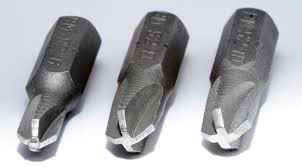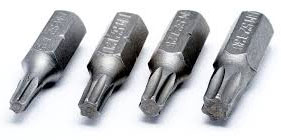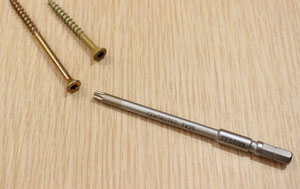|
|
|
|
The Down to Earth Woodworker
By Steven D. Johnson
Racine, Wisconsin
|
|
Previous Page
1
2
3
Screw Evolution
If you frequent the aisle full of
boxed screws
in the big-box store you have no doubt noticed an evolution. It seems like only a few years ago that every single screw, regardless of size, length, or material, had Phillips drive heads. Finding a slotted screw sent you back to the little "specialty" fastener bins the next aisle over to look through a limited selection. Slotted screws, it seemed, had been added to the scrap heap of history; for all intents and purposes, extinct.
For a little while, square drive screws were making inroads. Drywall screws, some construction screws, even some plain old wood screws were getting square drive heads, and the screw aisle at the store was getting a little more diversified. But square drive screws, at least as far as mass-market retail, are quickly heading for extinction too, and the population of screws sporting Torx, or what we sometimes call "star-drive" heads, is growing.
If you have been around the construction and woodworking arena for a while, you likely cheered the demise of the slotted screw. Slotted screws required an absolute perfectly fitted screwdriver, dead-center placement, and a steady hand, and even with great care the tip of the screwdriver often slipped out of the slot and ruined the surrounding wood or scratched the hardware being attached. Phillips head screws were so astoundingly better for woodworking that most of us cheered the death of slotted screws and readily adopted the "new" format.
Still, though, there were some problems. Phillips head screws would often "cam-out." This could happen when driving a screw by hand, but became even more problematic when using a modified electric drill for driving screws. Of course, as electric drills evolved from brute hole-drilling machines to polite battery-powered all-purpose drill-drivers, more of us exchanged the potential for carpal tunnel damage for the near-effortless machine-driving of screws… and the "cam-out" problem grew.
What most woodworkers probably don't know is that the Phillips head screw was designed specifically to cam-out. As factories and assembly lines adopted powered screw attachment devices, they needed a way to assure that screws would not be over-torqued. The Phillips head screw allowed a machine to drive a screw and if the machine potentially reached a torque level that would over-drive the screw, the head simply "cammed-out." Bet you didn't know that! Well, purposely "camming-out" a screw to adjust torque was, in hindsight, an inelegant way to solve a problem, but clutches on screw-driving machines had not yet been invented, much less refined and perfected to the level they are today.

|
|
Figure 4 - Phillips head screws... a thing of the past?
|
Still, even though the Phillips head screw was designed to "cam-out," we woodworkers thought the opposite, since we were comparing the Phillips to the slot, and as such, the Phillips was a vast improvement. Widespread adoption ensued, and there was a veritable population explosion in the world of Phillips head screws.
Our drilling-driving equipment, however, continued to evolve. Clutches got mechanically better, then with the advent of brushless DC motors and sophisticated on-board electronics, got smarter and technically more sophisticated. Then a few years ago we got the ratcheting hammer drill. All of a sudden, a rechargeable battery-operated hand drill-driver could drive a 6-inch long screw into a hardwood beam effortlessly. And the cam-out problem of Phillips head screws reached a critical point. Carpenters and woodworkers cheered the square drive screw, but that design, too, had some problems.
Square drive screws could, and did, still cam-out, though nowhere near as frequently as Phillips head screws. The big problem with square drive is that one of the things it was designed to do well annoyed a lot of us… the bit often "stuck" in the square drive recess. Handy when starting a screw, not so much when trying to drive screws repetitively and work fast. Another problem is that square drive heads, for some reason unfathomable to me, were generally bigger than their Phillip counterparts. And while I could find a solid assortment of square drive drywall screws, not much appeared at the local big-box store to extend the variety. The square drive screw just didn't seem to get the same "shelf space" as Phillips.

|
|
Figure 5 - The Star-drive or Torx head screw is infinitely superior
|
Enter the star-drive, or Torx screw. Like a storm, Torx-headed screws seem to be everywhere. In one store I visited recently there are no longer any… any… square drive screws, and the Torx screw selection is quite large.
With its six-lobed star-shaped design and carefully matched bits, Torx-head, or star-drive screws have made cam-out a distant memory. The Torx screw was invented and patented in 1967 by Textron (the aerospace conglomerate) to prevent the cam-out designed into Phillips head screws. The official international designation for this type of screw head is "hexalobular internal" but I doubt that name will catch on… "star drive" seems to be the name that will stick. By the way, the original Torx patent has expired, so manufacturers everywhere are making "star drive" screws and matching bits.

|
Figure 6 - A couple of different Torx-head screws and a finely
crafted Festool TX-25 Centrotec bit
|
There are many sizes of Torx-head or star-drive screw heads and bits, all designated with a "T" followed by a number. The most common size you will find in the big-box stores sport T25 heads, but a few other sizes are becoming common. The bit must match the head size perfectly (no "fudging" like can be done with Phillips bits), but when the match is made correctly, bits last seemingly forever.
Festool
, with their usual penchant for perfection, has a variety of
Centrotec bits
with Torx heads, and they fit perfect and are a dream to use.
I recently completed a room addition that included 2 X 8 ceiling joists, plywood roof decking, 2 X 4 wall construction, drywall, doors, windows, and skylights. As a sort of "mental exercise" I used all screws… not one single nail… for every stage of the construction. My ratcheting screwdriver/drill drove screws from 1-1/2" long to 8" long with ease. Warped construction-grade lumber was easily pulled into perfect alignment and every joint was tight. Screws offer much greater pull resistance than nails and essentially the same sheer strength, so when the rest of the house falls down, that room I added will still be there, standing strong. Of course, a nail gun has one big advantage… speed. When you are trying to hold a heavy board in place and attach it, a nail gun will get it done quickly, but a couple of clamps can do the holding for you and a screw will hold the board better if you can afford the few extra seconds.
Now I know there are purists among us woodworkers that still hunt relentlessly for slotted brass screws to give an authentic "period" look to a particular project, and that is fine. But if you are attaching hardware to cabinets, screwing together hidden components, attaching corner braces, or any of a host of other woodworking activities, the star-drive screw is vastly superior to slot-heads or Phillips.
Next month an old adage takes on new meaning for woodworkers, and I will also introduce you to my newest Festool "baby." And please be sure to
check out my latest video
as I make the haunched tenons for the rolling bypass doors.
(Page 3 of 3)
Previous Page
1
2
3

Steven Johnson is retired from an almost 30-year career selling medical equipment and supplies, and now enjoys improving his shop, his skills, and his designs on a full time basis (although he says home improvement projects and furniture building have been hobbies for most of his adult life). Steven can be reached directly via email at
sjohnson@downtoearthwoodworking.com
Return to the
Wood News Online
front page
|
|
|
|
|